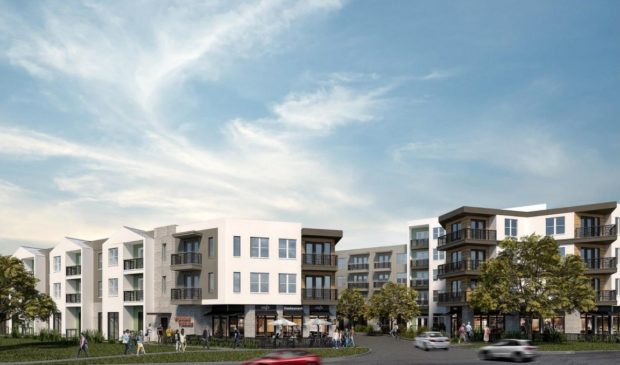Divided Board of Adjustment rejects site plan appeal
Friday, July 15, 2022 by
Jo Clifton A divided Board of Adjustment on Wednesday rejected a site plan appeal organized by the Windsor Park Neighborhood Association related to the redevelopment of the Windsor Village shopping center at 5900 Westminster Drive. What was once a small shopping center offering neighbors a chance to walk to shops and restaurants will now be transformed into a Vertical Mixed-Use development dominated by apartment buildings with some live-work space.
Neighbors who had agreed to VMU thinking they would be able to continue to eat tacos, buy clothing and run errands in the new development were shocked when they learned that most of the shops and dining areas would be eliminated. Instead, there will 405 apartments. As neighbor Kathryn Faehl wrote, “Increasing the density while substantially reducing the commercial space on the site is contrary to both common sense and Austin’s goals for a compact and accessible city.”
Although the final vote was 7-4 to reject the appeal, a majority of board members expressed dissatisfaction with their choices and promised to work to clarify parts of the Land Development Code related to VMU zoning. Only a supermajority vote could overturn staff members’ decision on a site plan, according to Assistant City Attorney Chad Shaw, but upholding the staff position required only a majority vote.
Stuart Hersh, who worked in areas related to land development regulation for the city for more than 30 years, represented the neighborhood as a pro bono advocate. He explained that only property owners within 200 feet of the proposed development could appeal. The Austin Mennonite Church was the official appellant.
Hersh laid out neighborhood arguments that the proposed development does not comply with the requirements of Vertical Mixed-Use, but said staff members have consistently applied the code in a way that allows such a development. The fact that staff had applied the code consistently did not mean that they had made the correct decision in granting the applicant’s site plan approval, he said. Several residents asked the board to overturn staff’s decision, noting that neighbors would never have agreed to VMU if they had known it could result in such an outcome.
A number of neighbors expressed dismay over the loss of the shopping center, noting that many of the businesses in the center had been forced to close. Jolene Keene, executive director of Accessible Housing Austin, wrote in support of the appeal. According to Keene, many low-income residents of a nearby housing development have depended on being able to walk to the shopping center for retail services. “Many of our residents use scooters and wheelchairs and will need sufficient sidewalks to visit any of the proposed amenities at the site location,” she wrote, saying that the plan lacks proper sidewalks and offers insufficient commercial services.
Craig Whisenhunt, a Windsor Park resident, noted in a letter to the board that the first iteration of the design was for an area bigger than 12 acres. The developer split the property into a number of smaller sites, “for the purposes of curtailing the requirements of the (Land Development Code) to perform proper reviews and designs, meeting the needs of a large phased development,” he wrote. An internal circulation route is one important requirement for a plan of five-plus acres.
Amanda Swor of the Drenner Group represented the applicant, Transwestern Development Company. However, Development Officer Brent Lloyd did most of the talking on behalf of city staff, arguing that staff had applied the code correctly and consistently.
The developer did start with the larger property, but the property being addressed in the appeal was reduced to 4.97 acres after subtracting the 1.7-acre parkland dedication required by the city. That’s just under the five-acre trigger for compliance with the internal circulation requirement; however, according to a memo from Lloyd, staff persuaded the applicant to provide internal connectivity, “and the proposed plans were revised to include a publicly accessible connection between Westminster and Berkman as well as pedestrian walkways throughout the site.”
Lloyd noted that staff did not want to include parkland in overall calculations in general because that could have the unintended consequence of allowing for more impervious cover on a site with contiguous parkland.
Swor said her client went through an equivalent approval process on the internal circulation. She noted that the developer worked with the Parks and Recreation Department for two years and that the department was the driver behind decisions about the size and placement of the 1.7-acre parcel of parkland. In answer to a question, she said the development is moving forward under three site development permits.
Board Member Richard Smith made a motion to grant the appeal. He argued that the parkland should have been included in calculations for determining site plan regulations and that the failure to do so “taints the entire process.” Several other board members agreed that the parkland should have been included, but lacked a clear idea of how to move forward if they upheld the appeal. Going into executive session to craft a motion would not have been legal under open meetings laws and board members had already been dealing with the case for more than three hours by that time.
Board Member Michael Von Ohlen argued at length against granting the appeal and made the motion to reject the neighbors’ request. However, he agreed with those who argued that the VMU portion of city code needs an overhaul.
Several members of the BOA agreed with the neighborhood that staff members had made mistakes in granting approval of the site plan, but placed blame on the code itself rather than the people charged with interpreting it.
Chair Jessica Cohen said the motion to reject the appeal was going to pass.
“And yet here we are again, dealing with a defunct code that is negatively impacting a large neighborhood that has put a lot of work into developing their neighborhood and making sure that it has equity and walkability, and not just trucks. I find that is frustrating. That is not the intent of what VMU is for.”
Cohen promised Hersh she would take his documentation with her to visit the Planning Commission to see if they could address the issues raised by the appeal.
Rendering of Windsor Village by Wilder Belshaw Architects.
The Austin Monitor’s work is made possible by donations from the community. Though our reporting covers donors from time to time, we are careful to keep business and editorial efforts separate while maintaining transparency. A complete list of donors is available here, and our code of ethics is explained here.
You're a community leader
And we’re honored you look to us for serious, in-depth news. You know a strong community needs local and dedicated watchdog reporting. We’re here for you and that won’t change. Now will you take the powerful next step and support our nonprofit news organization?








